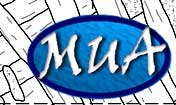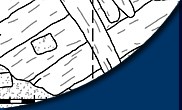
Excavations on EPII and Brick Wreck
7 July -11 July 2008
By Team 4:
Hans Schmid III, Aleks Adams, and Lynne Fobian
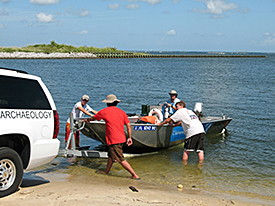
Students loading up boats.
This is an exciting week for us at field school. It is our half-way point so we received 3 newcomers to our teams. UWF has a combined field school option which allows students to experience both maritime and terrestrial field work. On Monday the students enrolled in the combined field school option switched. Alex, Courtney and Sean joined our maritime field school and Colleen and Ashley joined the terrestrial field school. We are sure that they will enjoy the experience. Our newcomers were introduced to the units they would be working on and oriented to the site. They were excited to be a part of our team.
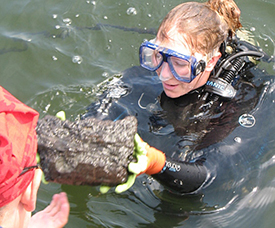
Tiffany bringing up a sample of wood from EPII.
On Monday the weather was threatening like normal but we knew that it was a 50/50 chance that we might get rained out, so we took our chances and went diving. The teams, both in the north units and the south units, have expanded their excavations. This is really broadening the view of the vessel. The north units are a lot different from the south units. There is no ballast to be hauled and more concretions. Team 1 and Team 3 are uncovering hull planking a mere 40 to 60 cm below the surface of the sea floor in the north units. In the south units we are uncovering a layer of oyster shell that once clung to the sunken ship. Below that are large ballast stones. Team 2 and team 4 are excavating as precisely as possible trying to subdue their desire to just dig blindly to find the hull and what might be resting at the bottom.
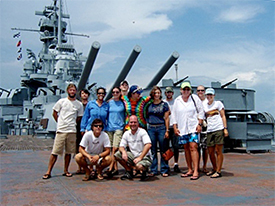
Field school staff and students on the USS Alabama.
Tuesday’s weather did not cooperate. The excavation teams made the trek to the boat launch only to see lightening flashing across the bay. Needless to say we opted for a hasty retreat. What to do with the rest of the day? There is always the USS ALABAMA. After unhitching the boats back at MSC, we loaded into the vehicles and headed off to Mobile, Alabama, only a 45 min drive from Pensacola. The USS ALABAMA is a World War II American battleship that is kept in the bay of Mobile. Adjacent to the battleship is the USS DRUM a World War II diesel submarine. We visited as much of the ship as time would allow. We could have spent days in their wandering around and still not have seen the whole ship. We ended the day with a group photo on the stern. During this field trip we observed ship construction techniques and machinery.
 .
.On Wednesday, several of us took a trip to the Brick Wreck to do a round of orientation dives to help familiarize several team members who recently arrived from the terrestrial field school. Christine and Dean took several of us on the pontoon boat to the site. Dean took each of us down individually to show us the general layout of the site and some of the more notable features. Jenn, Chris, and Alex each took their turn diving the site, after which Chris and Alex measured the location of a brick pile from the baseline while Jenn probed the northern extent of the wreck. Unfortunately due to deteriorating weather conditions, we were forced to return to the barge after only one dive.
On Thursday we returned to EP II and continued excavation on the southern unit at 86N 497E. Visibility was much improved from the last few days, but in place of poor visibility was an overabundance of large stinging jellyfish. Dredging on the first dive went smooth with the exception of a few stops to allow jellyfish to pass over our units, and despite our best attempts several people did fall victim to some wayward tentacles. On the second dive we saw that conditions were back to their usual self, with the change in tide bringing poor visibility back to the units. During this time Lynne was able to make a rough sketch of the unit by feeling through the suspended sediment and trying to determine the location of major features. Our goals for Monday will be to compare the two units, 87N and 86N and try to determine the lay out of the features and how they go together. It is exciting to see that they all join to produce one ship, an exciting piece of history. Just like doing a puzzle, as you add more pieces the picture becomes clearer.
On Friday, we again returned to EP II with hopes that the jellies had moved on, but that was not to be. The team member that mans the dredge usually keeps a lookout so the others can work, when spotted he or she then taps his teammates to move so the beautiful creature can gracefully flow through, then its back to work. Weather was a factor for us this morning and we kept an eye on it as we set up for the first dive. Team 4 was scheduled to dive on the second dive so we helped the first dive team with their gear and setting up the dredges. They were able to finish this dive before we decided to retreat to the shore for lunch and see if the weather would clear. It was decided that the weather was probably set in for the day so we sent a team to break down the dredges and secure the barge for the weekend. Hopefully the weather will cooperate for Monday, as we are all anxious to get back to our exciting puzzle of history on EP II.
Please feel free to contact us if you have any questions or concerns at: mua@keimaps.com.
Return to Project Journal home page.
